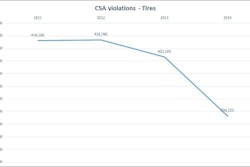Last month Frost & Sullivan released a new report addressing what the research firm has determined as the “Top 10 trends in the North American Mediumand Heavy-Duty Commercial Vehicle Aftermarket.”
Though I was unable to access the full report, an executive summary and press release helped me find the report’s top trends and some aftermarket predictions from the Frost & Sullivan team that produced the document.
Grouped into three categories, macro, maintenance and technology, Frost & Sullivan listed its industry trends as follows:
- Macro: Aging truck population, technician shortage outpacing demand, Right to Repair/CSA creating opportunities.
- Maintenance: Sustained remanufacturing growth, strong performance of OEM private label brands, total cost of ownership (TCO) a priority to fleets, opportunities in aftertreatment products.
- Technology: Truck parts ecommerce growing, connected trucks improving maintenance, leveraging big data.
To me most of those were unsurprising.
The aging truck population and tech shortages are casually or directly addressed at nearly every aftermarket event, as is Right to Repair (though I wouldn’t group that movement with CSA like Frost & Sullivan did). The maintenance and technology trends are equally common, and while I wouldn’t consider a growing focus from fleets on TCO as an aftermarket-specific trend, it definitely impacts how the aftermarket serves its customers.
Where I found the report to be most insightful was in its three predictions for the industry.
Frost & Sullivan predicts the following: The aftermarket will cross the $30 billion mark by 2020; the OES channel will gain 1 to 2 percent in market share on the strength of its private-label brands and telematics penetration; and parts e-commerce will likely account for 4 to 5 percent of aftermarket business by 2020.
So, one good thing, one bad thing, and a third thing that can be as good or bad as you want it to be.
To me that’s the story of the entire report. That there’s a realistic chance that one twentieth of all aftermarket sales will be online by the end of the decade. And if Frost & Sullivan’s first prediction is right, that’s more than $1.5 billion in online aftermarket purchases.
Wow.
Are you prepared to get in on that? If you’re not, you don’t have a lot of time. Crazy as it sounds 2020 is just 41 months away.
And sure, it would be easy to bury your head in the sand and say that prediction is high. It very well may be. But we both online sales aren’t going away. They are rising for nearly everything else; it’d be unrealistic to sit back and assume the aftermarket will avoid the trend.
Besides, all it takes one good experience.
That one time a customer needs something and they call you and you just can’t find it. You start searching for it, of course you do, but in the meantime they do the same on Google. They beat you to it by five minutes, then while ordering it from another distribfrutor three states over, they realize that distributor also has tail lights and trailer harness at prices 10 percent cheaper than you. And 24-hour free shipping if they reach a spending threshold. Suddenly their next stock order is smaller, and before you know it your profitability from them is drifting from black to red.
Creating an online sales tool won’t be cheap, but in the end, it’ll probably hurt less than that alternative.











